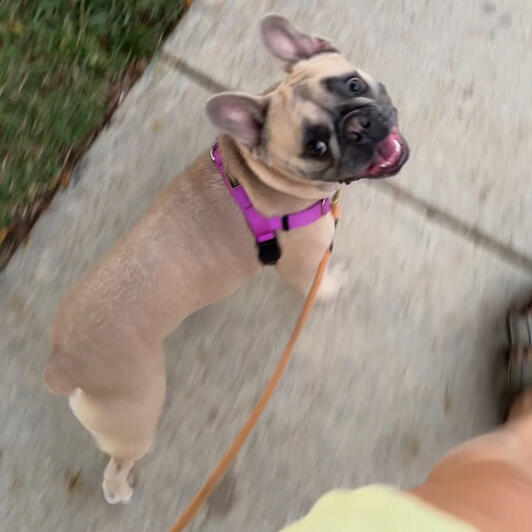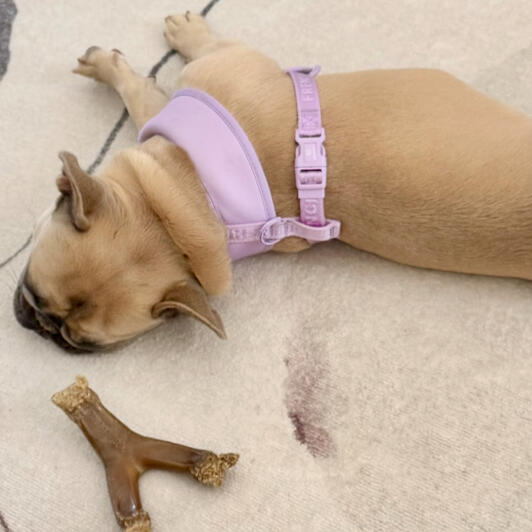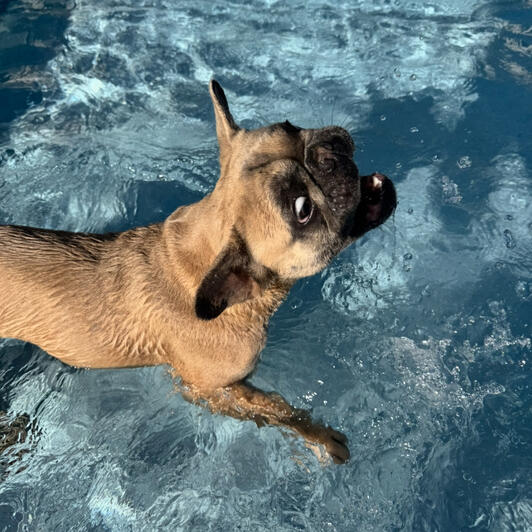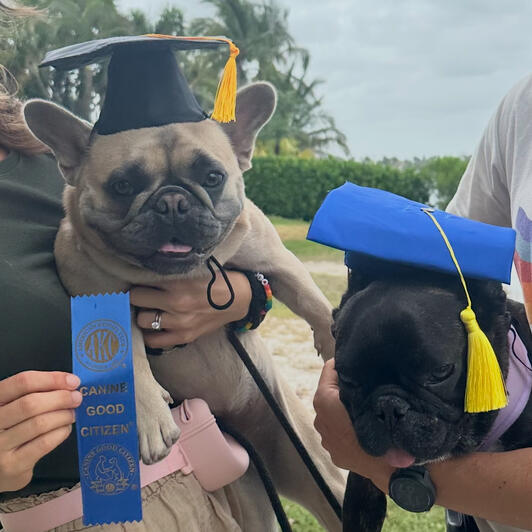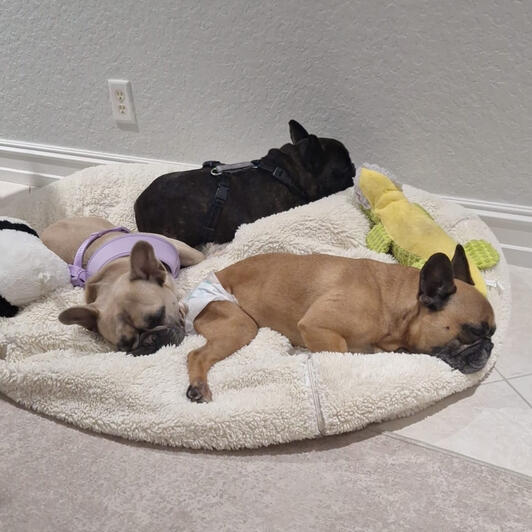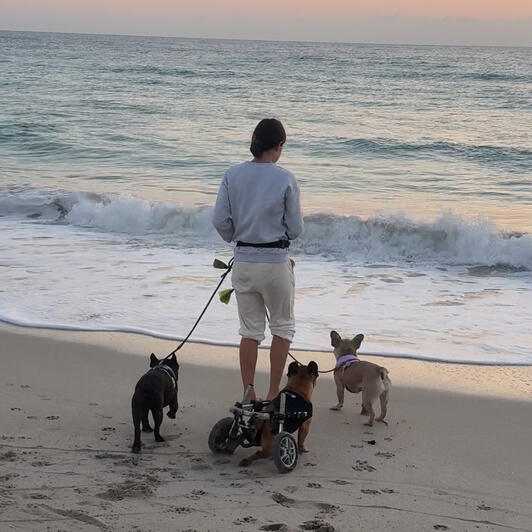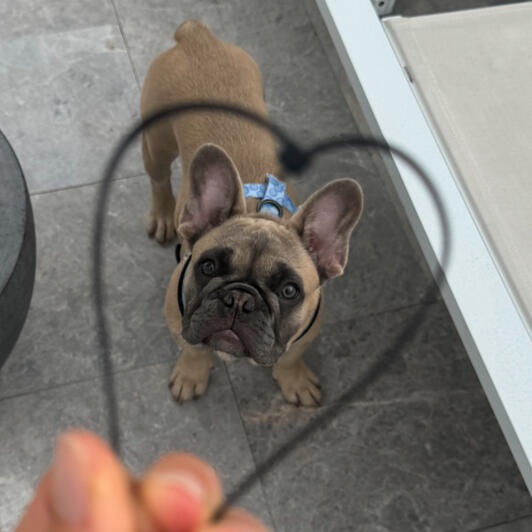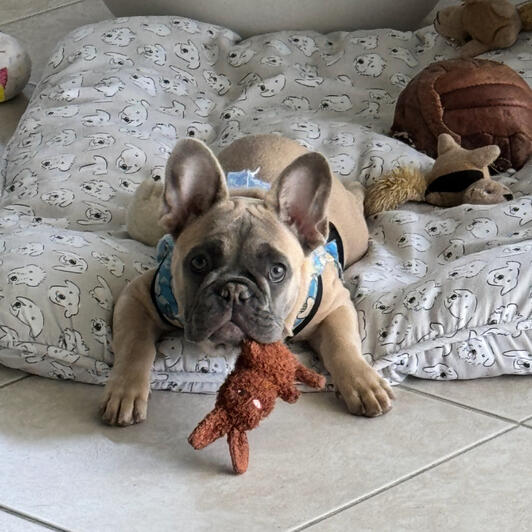This Is Mission Anna

Test first. Wiggle later.
Dogs may seem perfectly healthy on the outside, but hidden risks like bleeding or clotting disorders can lurk beneath the surface.
Anna’s story inspired this mission: she was a happy, seemingly healthy one-year-old French Bulldog who didn’t survive elective surgery due to an unseen bleeding disorder and silent underlying issues.
Why share this?
Because while anesthesia is now safer than ever (estimated canine mortality is around 0.7%), the risk changes based on dogs' ASA Physical Status Classification.
Dogs with ASA score III-V (sick) are at significantly higher risk of fatal complications related to surgery, and often require special anesthesia protocols to minimize the risk, compared to healthy dogs (score I-II).
Underlying and silent issues, which increase the ASA score, don't always present red flags — and when unknown, can lead to tragedy.
Testing can flag hidden disorders & underlying issues before surgery, reducing the risks for complications.
Doctors usually review medical history, do a patient exam, and run simple testing before a procedure to assess surgical fitness. But things like bleeding disorders aren't usually tested for, unless specifically requested.
PT/aPTT is a simple and inexpensive blood test that looks at the coagulation (clotting) pathways in the body, and can help diagnose such disorders.
Another useful tool is the C-reactive protein (CRP) test, which measures inflammation in the body. Elevated CRP can flag hidden issues—like infection or immune-related problems—that may increase surgical risk if left unchecked. In both humans and dogs, CRP offers a simple way to uncover inflammation that might otherwise be missed.
👉 The goal: not fear, but informed conversations with your vet.
Anna's Story

Who was Anna?
Anna was so much more than "just a dog". To us, she was our Anna Banana—our little girl, the center of our universe.She was joy in motion. A spark with paws. A heartbeat that lit up every space she walked into.She lived like life was one big celebration—of wiggles, zoomies, splashes, cuddles, and kisses. She didn’t simply exist beside us; she radiated through us, teaching us how to laugh louder, love harder, and stay rooted in the moment.To strangers, she was the dog who made you smile without even trying. To friends, unforgettable. To us, she was everything.Anna was my little baby. A mama’s girl, always curled into my arms in the evenings, her warmth stitched into my chest. A daddy’s girl, shadowing him with devotion, her big eyes saying, “You’re my person, too.” She was family in the deepest sense—woven into our days, into our routines, into our hearts.She was Cesar’s inseparable partner in chaos. Where he went, she followed, and where she went, he wiggled along right after. They invented whole worlds together: wrestling, chasing, conspiring in pure sibling silliness. She coaxed Charlie out of his shell and showed him how fun could look. Even Chloe, our aloof cat, couldn’t resist Anna’s orbit—because Anna’s love was confident, insistent, and impossible to turn away from.The pool was her kingdom. She’d march proudly in her life jacket, demand to be dropped into the deep end, and swim like she was chasing the sun itself. On land, she trained like every command was a game she planned to win. On walks, she trotted along happily but always glanced up with those huge puppy eyes—half “I love you more than anything in the world”, half “Your best girl definitely deserves another treat right now.” It was impossible not to laugh and give in.Everywhere she went, she reminded us that joy wasn’t passive—it was fierce, chosen, contagious.And oh, the kisses. They were her full-time job: relentless, wet, and healing. Anna nibbled ears, licked away sadness, and made sure love was never in short supply. She didn’t just give affection—she poured it, over and over, until you believed in joy again. She was our Crazy Banana—silly, sweet, and just the right amount of naughty, the kind of girl who could steal your heart and your snack in the same breath.Anna was wild and tender all at once. Curious, clever, unstoppable. A flash of zoomies one second, a warm weight against our side the next. She taught us to pause, to feel, to soak in the sweetness of now.She should still be here—swimming, wiggling, demanding one more treat. She was supposed to start exploring the world with us, filling years with adventures and joy. But in one devastating moment, the safety we trusted failed her.
When “Normal” Wasn’t Safe Enough
Everything was set for her next chapter—healthier, freer, unstoppable. Her surgery—BOAS, a common procedure for French Bulldogs—was carefully planned and chosen with love. We wanted Anna to run more freely, play without effort, and live the vibrant life she was always meant for.Her brother Charlie had gone through the very same surgery a year earlier at the same specialty hospital, with the same surgeon. He came home breathing easier, thriving. We had every reason to believe Anna’s story would be the same.But it wasn’t the surgery itself that failed her. It was something no one saw coming: an underlying bleeding disorder that her body had been silently carrying—pushed into crisis by pancreas issues we didn’t even know were there. Under the stress of surgery, her body spiraled into DIC, a catastrophic clotting failure that gave no warning until it was too late.That morning, I dropped her off as planned. She had bloodwork and x-rays—everything came back normal. No red flags. Nothing to suggest risk. But a few hours later, we got the call no parent should ever receive.Anna went into sudden cardiac arrest in the middle of the procedure. The team fought for her—multiple rounds of CPR, every effort to bring her back. At first, they suspected a clot. But the truth was harder: she was bleeding internally, silently, from a disorder no one thought to test for.We only learned the real cause because of a necropsy afterward. Without it, we might have been left forever with unanswered questions. And this is the reality: many families never find out what truly happened—and even the best, most careful veterinary teams may never know unless a necropsy is done and shared with them. Anna’s condition was so silent, so unexpected, that it only revealed itself after the fact.Had we known about her bleeding disorder, we could have a chance to investigate it.
Had we known about her underlying pancreas issues, we could have made different choices.
We might have delayed.
We might have mitigated.
We might have avoided the surgery altogether.
We never got that chance.Anna was a rescue, with an unknown family history. Aside from her Frenchie breathing issues, to us and to her vets, she looked vibrant, healthy, and ready for anything. She’d even been spayed before without complications. Looking back, we can’t help but wonder if there were tiny clues—but nothing that stood out enough at the time to raise concern from the many vets involved in her care. Her official pre-surgical score was ASA I–II: “low risk.”No one suggested clotting tests. Not because they didn’t care, but because it isn’t standard unless something obvious points that way. The problem is—sometimes there are no red flags. Sometimes the only warning is the loss itself.But her blood couldn’t clot. And if we had known, everything might have been different.Even one extra precaution—something as simple as a PT/aPTT clotting test—might have revealed abnormalities. It might have prompted questions. It might have led us to uncover her pancreas issues in time. It might have given us a chance to protect her.We’ll never stop carrying the weight of that “might have.” But we can share what we’ve learned, so other families have the chance to ask questions we didn’t know to ask. Even one extra precaution can open a door that otherwise stays closed.This is why this mission exists.
This is Mission Anna.
Ask before surgery.
Ask even if they seem fine.
Ask for the clotting test.
Here’s what you can say to your surgeon / vet:
Script 1 (for any dog):“I’d like my dog to have PT and aPTT tests before anesthesia. I know they’re not perfect, but I want to check for hidden bleeding and clotting risks.”Script 2 (for higher-risk dogs — rescues, unknown history, and/or brachycephalic/flat-faced breeds):“Because my dog’s background and breed can carry hidden risks, can we do coagulation testing (PT/aPTT) — and if appropriate, additional tests like von Willebrand factor test to minimize the chances of sudden surgical complications?”
FAQ
❓ Do all dogs need this?
Not necessarily. The majority of healthy dogs (ASA I-II) do fine with only standard pre-surgical testing and without the need for anything special on top of it. But not all seemingly healthy dogs are actually healthy.For dogs with unknown histories, certain health compromised breeds (like French Bulldogs and brachycephalics in general), breeds with known inherited clotting factor deficiencies, dogs with a history of abnormal liver values, or dogs with even subtle signs of coagulation issues, the coagulation test might be the difference between a lifetime of wiggles and a terrible heartbreak.
🩸 What are some examples of subtle signs of a clotting problem in dogs?
Clotting issues don’t always show up before a procedure, especially not as dramatic bleeding. If any, the signs are small and because they don't guarantee a bleeding disorder, they can easily be missed or brushed off. Some important things to watch for include:- Bleeding from the mouth or gums while chewing toys or food
- Tiny red dots (petechiae) on gums, ears, or belly
- Unexplained bruises
- Blood in urine (pink or red-tinged pee, especially if UTI is ruled out)
- Dark, tarry stools (digested blood) or red streaks in stool
- Prolonged bleeding from nail trims, cuts, or small wounds
- Oozing or delayed bleeding after injections or surgeries
- Swollen joints, belly, or unexplained limping (possible internal bleeding)
- Pale gums, fatigue, or weakness (from slow blood loss)
- NosebleedsThese signs don’t always mean your dog has a serious disorder, but they’re important red flags for a dog who has it. If you see any of them—especially before a surgery or dental procedure—speak with your vet about coagulation testing.
⚖️ What are ASA scores, and how do they change the risk of anesthesia?
The ASA (American Society of Anesthesiologists) physical status classification helps vets assess how “fit” a dog is before anesthesia—ranging from ASA I (healthy) to ASA V (moribund). The classification is based off of physical examination of the patient and evaluation of medical records. The more records and test results you have, the better they can assess the risk.
According to a global study from 2024, even mild systemic disease, ASA II, more than triples the mortality risk compared to truly healthy dogs (from 0.07% to 0.24%). 1 in 100 dogs classified as ASA III will not make the surgery. For ASA IV, the risk jumps up to 1 in 15 dogs, and ASA V (critically ill, unlikely to survive without surgery) is around 15.73%, so a heartbreaking number of about 1 in 6 dogs.
🐶 Are brachycephalic dogs at even higher risk?
Brachycephalic breeds (e.g., Bulldogs, Frenchies, Pugs) add another layer of danger. A study from 2018 found that they’re over 4 times more likely to have post-anesthesia complications than non-brachycephalic dogs—and those complications can become fatal, especially given the breathing vulnerabilities. They also noted slightly higher risk of complications during anesthesia vs non-brachycephalic dogs.While not scientifically proven, dogs with well-recognized breed health challenges, like French Bulldogs these days, often present with unexpected, sometimes hidden issues, so additional pre-surgery testing (like coagulation tests) should be considered to minimize the risk of complications.
🧪 What does PT/aPTT actually test?
The blood test screens how long it takes blood to clot via certain pathways. It is a great tool to help detect problems with clotting factors, which can lead to internal bleeding, but it won’t catch every coagulation disorder.Prolonged PT/aPTT = meaningful. That’s when you need to worry about bleeding risk during surgery.Normal PT/aPTT ≠ all clear. The reason why it doesn't mean "all clear" is that they miss platelet problems, hypercoagulability, and subtle deficiencies.Short PT/aPTT = ignore. Not diagnostic of clotting disorder.
🚫 What doesn’t it show?
No test is perfect. The risk of hypercoagulability (blood clotting too easily) will not be diagnosed by PT/aPTT. Conditions like von Willebrand disease, certain clotting factor deficiencies, or platelet function problems may show up on PT/aPTT, but they might also require additional tests like a vWF assay or TEG/ROTEM. That’s why a normal test result is reassuring but not a full green light. Your vet will be the best person to suggest what additional tests are relevant for your dog and their unique needs.
If you have access to your dog's family history, genetic conditions like vWD should have been ruled out (with proof of genetic testing) by an ethical breeder.
What does C-Reactive Protein (CRP) Test do?
The CRP test measures a protein made by the liver that rises when there’s inflammation in the body. While it doesn’t reveal the exact cause, it can act as an early warning signal of hidden issues—from infection to autoimmune conditions. In some cases, even a mildly elevated CRP may point to risks that deserve a closer look before surgery.
🥼 What about hidden pancreas issues? How can that be diagnosed in time?
Unfortunately, pancreatic disease can be sneaky. Some dogs show classic warning signs — vomiting, belly pain, diarrhea, loss of appetite — but others, like Anna, may appear completely normal right up until surgery or a health crisis. As with the bleeding disorder, we only learned about her chronic and acute pancreas issues because of her necropsy.If there are warning signs, vets usually screen for pancreatic inflammation with a Spec cPL (specific canine pancreatic lipase) test. It’s a simple blood test that detects pancreatic stress.
In Anna's case, a CRP test would have possibly detected inflammation in her body, but this test alone wouldn’t have said “it’s her pancreas.” It might have waved a red flag that there was active inflammation somewhere. As a follow up, an abdominal ultrasound, if abnormal PT/aPTT test results had been found and no clear explanation was given or the CRP was showing as increased, might have revealed pancreatic changes earlier. But that's only our speculation, as we cannot go back in time and find out for sure. Unfortunately, no test can ever guarantee to reveal every issue, but asking for further testing, even if they seem fine, gives you the best chance of staying ahead of a tragedy.
📚 What do experts say?
The American Animal Hospital Association (AAHA) and the American College of Veterinary Anesthesia & Analgesia (ACVAA) both agree: every dog deserves a thorough pre-anesthetic assessment, with follow-up testing driven by history, examination, and individual risk factors.The Merck Veterinary Manual underscores a critical point: dogs can carry congenital or acquired coagulation defects that often remain silent—until a trigger like surgery or trauma exposes them. Conditions like DIC are typically secondary to an underlying issue, and identifying those issues early can be a lifesaving move.A 2025 retrospective study at Universidad Cardenal Herrera‑CEU’s teaching hospital in Valencia, Spain, examined 350 pre‑anesthetic cases. Additional lab work, including clotting tests, led to cancellations or postponements in 16 percent of procedures—actions based on unseen internal risks that physical exams alone failed to flag.A 2018 retrospective cohort study in the Journal of the American Veterinary Medical Association compared 223 brachycephalic dogs to 223 non‑brachycephalic dogs undergoing similar procedures. Results showed that while around half of all dogs experienced perianesthetic complications, brachycephalic dogs were far more likely to develop post‑anesthetic complications (13.9 percent) compared to non-brachycephalic dogs (3.6 percent)
🐾 What else can I do to help my vet fully assess my dog for surgery?
When it comes to surgery prep, always bring the basics: every piece of medical history you’ve got, plus a list of all meds and supplements. A good vet will always ask about the big things as well — coughing, collapsing, seizures, weight changes, etc. But what often gets missed are the small, everyday details that don’t sound like medical problems at first glance. In addition to what's already covered above, here are some other things to speak up about, even if they feel silly:- Tiring faster than usual on a familiar walk
- Vomiting after play or bursts of excitement
- Taking longer to bounce back after excitement or activity
- Getting unusually restless or panting harder than other dogs in mild heat
- Drinking a little more water than normal, or asking to go out at night
- Subtle shifts in appetite, like leaving food behind once in a while
- A change in how their poop or pee looks (even if they seem fine otherwise)
- Odd moments of “spacing out” or staring into space
- Sudden clinginess or being more “needy” than usual
- Pausing at the stairs or hesitating with things they normally do with ease
- Sudden dislike of being picked up, hugged, or touched in a certain spotThese, and other, tiny details often don’t come up in a standard pre-surgical questionnaire, but they can be important pieces of the puzzle. If you notice it - even once - mention it.Vets only get a snapshot of your dog. You’re the one who sees the full story.(And if you can catch a weird moment on video, bring it. Vets love that. It’s like giving them subtitles to your dog’s secret language.)
Sources
- Redondo Jl et al. (2024), Anaesthetic mortality in dogs: A worldwide analysis and risk assessment. Veterinary Record, 195(7), e3604.
- 2020 AAHA Anesthesia and Monitoring Guidelines for Dogs and Cats
- AAHA article on anesthetic considerations for brachycephalic breeds (2025)
- 2025 ACVAA Small Animal Anesthesia and Sedation Monitoring Guidelines
- eClinPath (2025). “Coagulation assays (PT, APTT) – what they mean and what they don’t detect.”
- Merck Veterinary Manual: Coagulation Protein Disorders in Animals
- Influence of Comprehensive Pre-Anaesthetic Assessment on ASA Classification and Surgical Cancellations in Dogs and Cats: A Retrospective Observational Study
- Mitchell et al. (2018), Effect of routine pre-anesthetic laboratory screening on anesthetic risk predictions
- Cornell Comparative Coagulation Laboratory (DIC & Thrombosis)
This site is for educational purposes only and does not provide medical advice. Always consult your veterinarian for diagnosis and treatment. Mission Anna is not responsible for medical outcomes.Page last updated: Aug 2025

